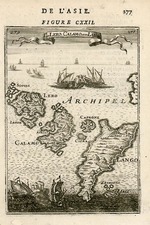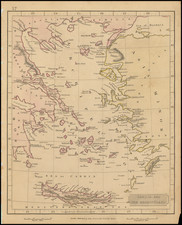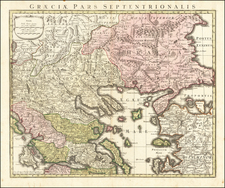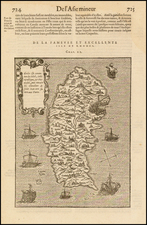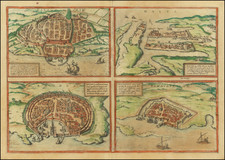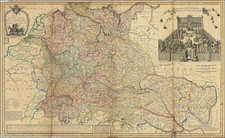Gastaldi Map of Greece, Dedicated to a Fugger. One of "the best works of Gastaldi" (Bifolco and Ronca).
One of the earliest obtainable modern maps of Greece and the Aegean Sea produced by one of the great mapmakers of the 16th century. Comprising a separate issue of the lower right sheet of Gastaldi's wall map of southeastern Europe, this uncommon map is a leading example of Lafreri School cartography. The map was published in Venice in 1560.
The map spans from Albania and Macedonia in the northwest through to Turkey in the east and Crete in the south. Greece is shown in full, and the many islands of the Agean are centered on a magnificent compass rose. Detail is shown in a magnificent Lafreri School manner, with many rounded hills and pictorial cities shown. The sea is stippled, as in most Italian maps of this period.
This map was actually used as a part of two maps that Gastaldi produced in 1560. It appeared both as the eastern sheet of a rare one-and-a-half-sheet map of Greece, which extends slightly further west than the present map and as the southeasternmost sheet of a four-sheet wall map of southeastern Europe previously mentioned.
The 1560 wall map was dedicated to Johann Jakob Fugger and recorded by Bifolco and Ronca as being one of Gastaldi's best works, with Gastaldi himself considered to be one of the best Italian mapmakers of the 16th century. The project for the wall map was started in 1559 and completed in 1560. The map was engraved by Fabio Licinio, and, when ready, the map was sold in Venice and Rome, with a second state bearing a Lafreri imprint. Bifolco and Ronca note that the two southern sheets in the map were oftentimes separately issued as maps of the Kingdom of Naples and Greece.
The Lafreri School is a commonly used name for a group of mapmakers, engravers, and publishers who worked in Rome and Venice from ca. 1544 to 1585. The makers, who were loosely connected via business partnerships and collaborations, created maps that were then bound into composite atlases; the maps would be chosen based on the buyer or compiler’s interests. As the maps were initially published as separate-sheets, the style and size of maps included under the umbrella of the “School” differed widely. These differences can also be seen in the surviving Lafreri atlases, which have maps bound in with varying formats including as folded maps, maps with wide, trimmed, or added margins, smaller maps, etc.
The most famous mapmakers of the School included Giacomo Gastaldi and Paolo Forlani, among others. The School’s namesake, Antonio Lafreri, was a map and printseller. His 1572 catalog of his stock, entitled Indice Delle Tavole Moderne Di Geografia Della Maggior Parte Del Mondo, has a similar title to many of the composite atlases and thus his name became associated with the entire output of the larger group.
Giacomo Gastaldi (1500-1566) is considered the foremost Italian cartographer of the sixteenth century, alongside Paolo Forlani. His skills of compilation are comparable to those of Mercator and Ortelius, yet much less is known of his life than of his two contemporaries. Gastaldi was born in Villafranca, Piedmont, but had established himself in Venice by 1539. He originally worked as an engineer, but turned to mapmaking from the 1540s onward.
It was in Venice where he made his reputation as an engraver, geographer, and cosmographer; for example, he was asked to fresco maps of Asia and Africa in the Palace of the Doge, or the Council of Ten, Venice’s governmental body. He also frequently consulted on projects for the Savi sopra la Laguna, drawing maps for this body which oversaw the regulation of fresh and salt water around Venice.
His contemporaries also recognized his skill, as he was named cosmographer to the Republic of Venice, was a member of the Accademia Veneziana, and was a major source for other geographers and mapmakers including Camocio, Bertelli, Cock, Luchini, and Ortelius. He even had his own distinct style of copper engraving that made him a pioneer in his day and makes his works iconic today.
Gastaldi enjoyed an especially productive relationship with Giovanni Battista Ramusio, Secretary of the Venetian Senate, who used Gastaldi's maps for his famous travel account collection, Navigationi et Viaggi. Gastaldi also tutored Ramusio's son in cosmography.









